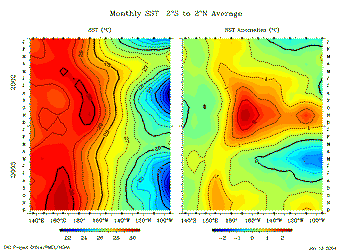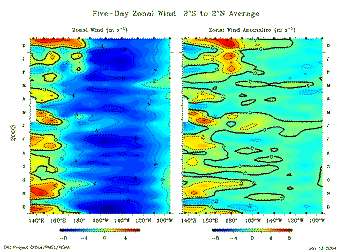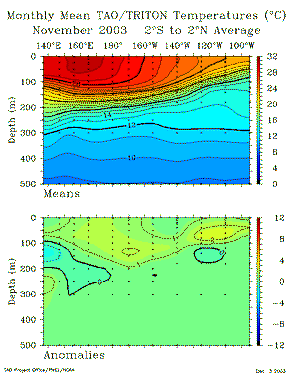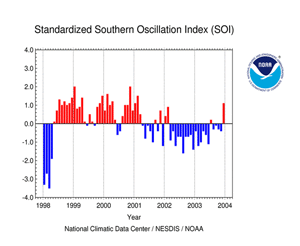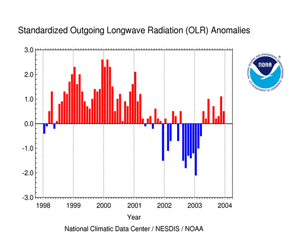The year began with the equatorial Pacific Ocean in an El Niño/Southern Oscillation (ENSO) warm event. This El Niño warming began in mid-2002, and reached its maturity in November 2002 when the sea-surface temperature (SST) anomalies in the Niño 3.4 region (map of Niño regions) reached their warmest condition with a +1.54°C (+2.77°F) SST anomaly.
Beginning in January of 2003, the anomalously warm waters in the oceanic mixed-layer in the eastern equatorial Pacific began to slowly cool. Between December 2002 and January 2003, the SST anomaly in the Niño 3.4 region decreased from +1.42°C (+2.55°F) to +0.66°C (+1.18°F). This cooling spread westward, and had affected the ocean conditions basin-wide in the February monthly mean ocean temperatures. The trend in SST anomalies was also evident in the western Pacific Ocean, reflected in the anomalies measured in the Niño 4 region. The observed cooling trend in basin-wide SSTs continued through March. The dissipation of the warm event and the transition to near-neutral ENSO conditions occurred in April, when the SST anomalies cooled to near-normal across the equatorial Pacific basin. However, the atmospheric signal lagged the ocean, with the Southern Oscillation Index (SOI) remaining negative through June (see discussion below).
After the El Niño event had dissipated in April, ocean surface and sub-surface temperatures began to rapidly cool. This cooling suggested the development of a La Niña cold event in the eastern and central equatorial Pacific. By the end of May, SST anomalies in the eastern and central equatorial Pacific had cooled to below -1.5 °C adjacent to the South American coast. The cold anomaly in the Niño 3.4 region was -0.63°C (-1.13°F) in May. The rapid cooling was generated by the return of easterly trade winds across the near-equatorial region, which increased equatorial upwelling in the eastern Pacific in April and May.
The colder than normal SST anomalies extended into the middle of June, but were abruptly halted when a strong westerly wind event propagated across the equatorial Pacific basin. This westerly wind event (these are often referred to as wind bursts) is evident in the zonal wind (U-component wind) anomalies averaged over 5-day periods in the equatorial zone. The westerly wind event was first observed in early May in the far western Pacific, and then moved eastward during June. This event generated an eastward propagating oceanic Kelvin wave, that eroded the cold SST anomalies that had developed in the central and eastern Pacific during the previous two months.
Since the cessation of the cold SST anomalies in June, the equatorial Pacific region has slowly warmed. This observed warming has not yet developed into an El Niño, but the SST anomalies have been consistently warm since July in both Niño regions (map of Niño regions). Anomalously warm SSTs have been been measured in the Niño 3.4 region for the past 5 months, and the SST anomaly had reached +0.54 °C (+0.97 °F) for the November mean. The warm oceanic conditions were also present in the sub-surface measurements from NOAA's array of moored buoys. Warmer than normal conditions were evident in the mixed-layer during November across the entire Pacific basin, although the observed ocean temperatures were well below the peak warmth observed during the 2002-2003 El Niño event.
The atmospheric indices measured during the latter half of 2003 in the Pacific region showed mixed signals regarding their response to the observed warming in the oceanic mixed-layer. The Southern Oscillation Index (SOI) was consistently negative during the first 6 months of 2003, which lagged the dissipation of the El Niño event. The SOI switched signs in July to a positive index value, but then reversed back to a negative index value in August 2003, and has remained so since that time (see the latest SOI graph). Deep tropical convection in the western and central equatorial Pacific typically responds to the warm waters associated with ENSO warm events, and this is measured by Outgoing Longwave Radiation (OLR) across the western and central Pacific region. OLR anomalies were strongly negative in early 2003, in response to the warm SSTs during the El Niño. However, they have remained positive since April, despite the more recent warming in the equatorial Pacific Ocean observed since July (see the latest OLR Anomaly graph). At the end of November 2003, the atmospheric signal was mixed, with the SOI reflecting the warm SST anomalies, and the OLR remaining positive and reflecting a weak La Niña type signature.
Additional Links
- ENSO Monitoring
- NOAA El Niño / La Niña Index Definition
- NOAA's Pacific Marine Environmental Laboratory (PMEL):
- NOAA's Climate Prediction Center (CPC):
- NOAA's Physical Science Laboratory
- NASA/JPL Ocean Surface Topography from Space
- Australian Bureau of Meteorology (BoM) Climate Driver Update
- IRI - International Research Institute
 NOAA's National Centers for Environmental Information
NOAA's National Centers for Environmental Information
